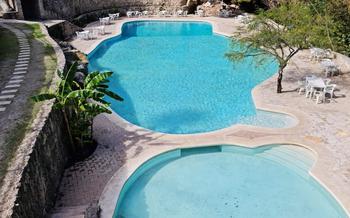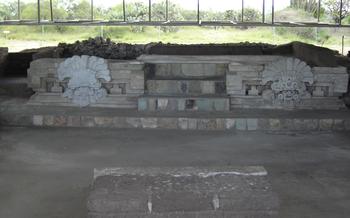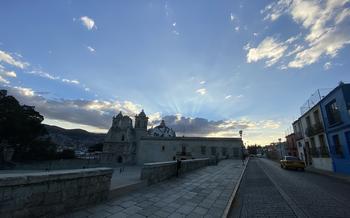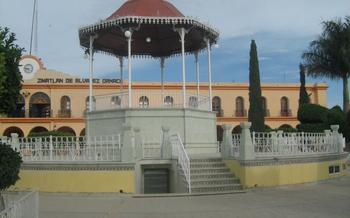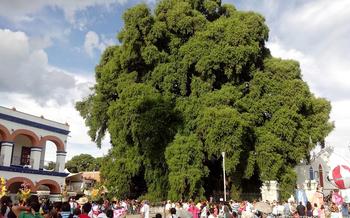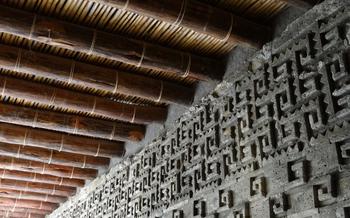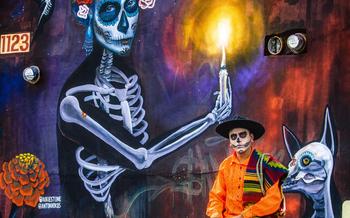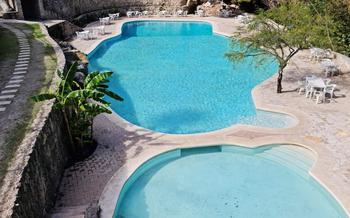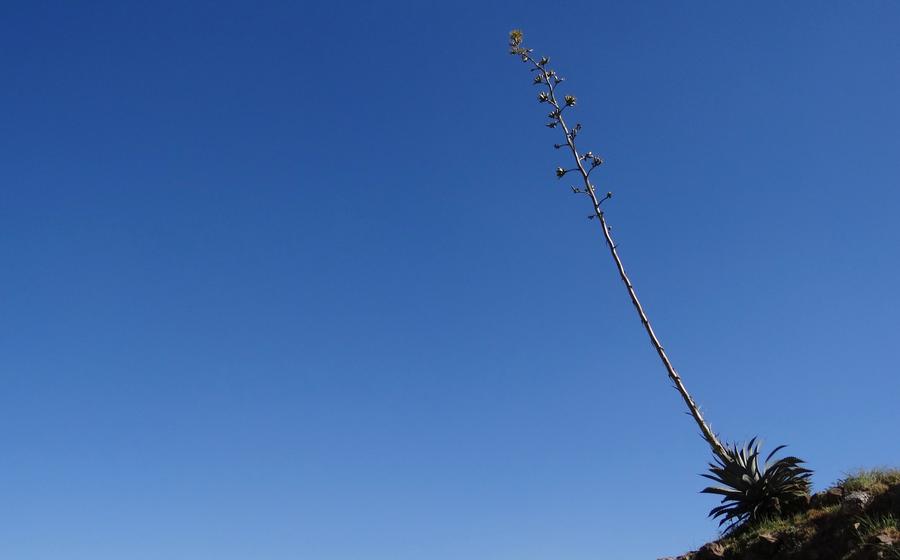
Monte Albán Archaeological Site
- Monte Albán Archaeological Site: A Journey Through Time
- Unveiling the History of Monte Albán
- Exploring the Ruins of Monte Albán
- Central Plaza
- North Platform
- South Platform
- Danzantes Reliefs
- The Great Plaza: A Place of Ceremonies
- The South Platform: A Masterpiece of Zapotec Engineering
- The Danzantes Reliefs: A Mysterious Legacy
- Practical Information for Your Visit
- Tips for Making the Most of Your Visit
- Capture the Beauty of Monte Albán
- Beyond Monte Albán: Exploring Oaxaca's Treasures
- Oaxaca's Vibrant Culture and Cuisine
- Insider Tip: Off-the-Beaten-Path Gems
Monte Albán Archaeological Site: A Journey Through Time
Journey back in time to the ancient Zapotec city of Monte Albán, a remarkable archaeological site nestled in the picturesque Oaxaca Valley. Perched atop a hill, this UNESCO World Heritage Site offers a glimpse into one of Mesoamerica's most significant civilizations. Explore the architectural wonders, unravel the rich history, and immerse yourself in the captivating culture of the Zapotec people.
Unveiling the History of Monte Albán
Monte Albán's history is intimately entwined with the rise and fall of the Zapotec civilization, one of the most prominent Mesoamerican cultures. The Zapotecs, believed to have originated in the Oaxaca Valley, established Monte Albán as their political and economic center around 500 BC. Over the centuries, the city flourished, becoming a major trading hub and a center of cultural and religious significance.
The Zapotecs constructed magnificent temples, palaces, and tombs at Monte Albán, leaving behind a legacy of impressive architecture. The city's strategic location atop a hill provided both defensive advantages and panoramic views of the surrounding valleys. Monte Albán's influence extended far beyond its immediate surroundings, as the Zapotecs established trade routes and alliances with neighboring regions.
In the 9th century AD, Monte Albán's power began to decline, eventually leading to its abandonment. The reasons for this decline are still debated, with theories ranging from environmental factors to political upheaval. Despite its eventual abandonment, Monte Albán's legacy lived on, and the site remained a place of pilgrimage and veneration for centuries after its fall.
In the 20th century, archaeological excavations at Monte Albán shed new light on the site's history and significance. The discovery of numerous artifacts, including the iconic Danzantes Reliefs, provided valuable insights into Zapotec culture and beliefs. In 1987, Monte Albán was designated a UNESCO World Heritage Site, recognizing its outstanding universal value and cultural heritage.
Exploring the Ruins of Monte Albán
Monte Albán's ruins are a testament to the Zapotec civilization's architectural prowess and cultural significance. The site is divided into several sections, each with its unique features and attractions.
Central Plaza
The Central Plaza is the heart of Monte Albán, a vast open space surrounded by monumental structures. Here, you can admire the Great Platform, a massive pyramid that dominates the plaza and offers stunning views of the surrounding valley. The plaza was used for public gatherings, ceremonies, and market activities.
North Platform
The North Platform is located to the north of the Central Plaza and is home to several important structures. Here, you can explore the Juego de Pelota, a ball court where the ancient Zapotecs played a ceremonial ball game. The North Platform also features several tombs and burials, as well as elite residences adorned with intricate glyphs and inscriptions.
South Platform
The South Platform is located to the south of the Central Plaza and is known for its impressive engineering feats. Here, you can see the elaborate terraced platforms, which were used for agriculture and water management. The South Platform also features defensive structures, such as walls and fortifications, which protected the city from enemy attacks.
Danzantes Reliefs
One of the most intriguing features of Monte Albán is the Danzantes Reliefs, a series of carved stone slabs depicting human figures. These reliefs are believed to represent prisoners or dancers and are thought to have played a role in Zapotec rituals and ceremonies. The Danzantes Reliefs provide valuable insights into the religious beliefs and practices of the Zapotec civilization.
The Great Plaza: A Place of Ceremonies
The Great Plaza, the heart of Monte Albán, is a testament to the Zapotec's architectural prowess and spiritual beliefs. Constructed on a leveled platform, this vast open space served as a stage for religious rituals, political gatherings, and public ceremonies.
The plaza's defining feature is its impressive staircase, flanked by towering platforms and adorned with intricate carvings. These platforms, known as Building J and Building L, display masterful stonework and served as platforms for temples, shrines, and administrative buildings.
At the center of the plaza lies a large stone slab, known as the Danzante Platform. It is believed to have been used for ritual dances, with dancers performing to honor the gods and celebrate important events. The platform's name, meaning "dancers" in Spanish, originates from the numerous carved figures depicted on its sides, which are believed to represent dancers or prisoners.
The Great Plaza also features a ball court, a common feature in Mesoamerican cultures. The ball game, known as tlachtli, was not merely a sport but a sacred ritual with deep religious and symbolic significance. The court's design, acoustics, and alignment suggest that the game held great importance in Zapotec society.
Surrounding the plaza are stelae and altars, carved stone monuments that served as markers for important events, commemorated victories, and honored rulers. These monuments provide valuable insights into Zapotec history, culture, and belief systems.
The South Platform: A Masterpiece of Zapotec Engineering
The South Platform of Monte Albán showcases the remarkable engineering prowess of the Zapotec civilization. The platform consists of a series of interconnected terraces that rise in stepped levels, creating a stunning architectural spectacle. These terraces were constructed using massive stone blocks, demonstrating the Zapotecs' expertise in construction and their ability to mobilize a large workforce.
The South Platform served various purposes. Its terraced design provided a practical solution for farming, allowing the Zapotecs to cultivate crops on different levels, maximizing the use of available land. The terraces also functioned as a water management system, capturing and retaining rainwater for agricultural purposes. Additionally, the platform's strategic location offered defensive advantages, with its elevated position providing a vantage point for surveillance and protection against potential threats.
The panoramic views from the South Platform are breathtaking. Visitors can enjoy sweeping vistas of the surrounding landscape, including the verdant valleys, rugged mountains, and the distant cityscape of Oaxaca. The combination of engineering ingenuity, agricultural practicality, and defensive strategy makes the South Platform a testament to the advanced civilization that thrived at Monte Albán.
The Danzantes Reliefs: A Mysterious Legacy
One of the most intriguing features of Monte Albán is the collection of carved stone slabs known as the Danzantes Reliefs. These enigmatic sculptures, dating back to the 6th century BC, depict rows of human figures in various poses and expressions. While the exact meaning of these reliefs remains a mystery, scholars believe they may represent prisoners of war, dancers engaged in religious ceremonies, or a combination of both. The Danzantes Reliefs offer a glimpse into the complex belief system and artistic traditions of the Zapotec civilization. Their unique style and iconography have made them one of the most iconic symbols of Monte Albán and a testament to the creativity and skill of the Zapotec people.
Practical Information for Your Visit
To ensure a smooth and enjoyable visit to Monte Albán, here are some practical details to keep in mind:
Location and accessibility: Monte Albán is located approximately 10 kilometers southwest of Oaxaca City, the capital city of Oaxaca state. It is easily accessible by car or guided tour from Oaxaca City, with a scenic drive that takes around 30 minutes.
Opening hours and admission fees: The archaeological site is open to visitors daily from 8 am to 5 pm. Admission fees are reasonable, and discounts are available for students and seniors.
Guided tour options: Guided tours are highly recommended to gain a deeper understanding of the site's history and significance. Tours can be arranged through local tour operators or directly at the site's entrance.
Facilities and amenities: Monte Albán offers basic facilities for visitors, including restrooms, a small museum, and a souvenir shop. However, it's essential to note that the site is mostly outdoors, so visitors should come prepared with water, sun protection, and comfortable shoes.
Tips for Making the Most of Your Visit
To make your visit to Monte Albán a truly memorable experience, here are some insider tips to keep in mind:
-
Plan your visit during the dry season (November to April) to avoid the scorching summer heat and unpredictable rains. The weather during these months is pleasant and ideal for exploring the ruins.
-
Choose comfortable footwear. You'll be doing a lot of walking on uneven terrain, so make sure you wear shoes with good support and traction.
-
Bring water and sun protection. The sun can be intense at Monte Albán, so it's essential to stay hydrated and protected from the UV rays. Carry a refillable water bottle and apply sunscreen regularly.
-
Allow ample time to explore. Don't rush your visit to Monte Albán. Take your time to wander through the ruins, admire the intricate carvings, and soak in the breathtaking views. Allocate at least half a day or even a full day to fully appreciate the site's wonders.
Capture the Beauty of Monte Albán
Monte Albán is a photographer's paradise, offering endless opportunities to capture the beauty of this ancient Zapotec city. The sprawling ruins, with their intricate carvings and impressive architecture, provide a stunning backdrop for your shots.
- Photography Guidelines:
- Respect the site and its cultural significance:
- Use a tripod to minimize camera shake and ensure sharp images.
- Be mindful of other visitors and avoid blocking their views.
- Refrain from using flash photography, as it can damage the delicate ruins.
- Instagram-Worthy Spots:
- The Great Plaza:
- Capture the grandeur of the central plaza with its imposing buildings and sweeping views.
- Experiment with different angles to create dynamic compositions.
Look for details like the carved glyphs and intricate stonework.
The North Platform:
- Take advantage of the elevated vantage point to capture panoramic shots of the site.
Focus on the tombs and elite residences, which offer glimpses into Zapotec burial practices and daily life.
The South Platform:
- Photograph the terraced platforms, water management systems, and defensive structures that showcase Zapotec ingenuity.
Capture the stunning views of the surrounding valley and mountains.
The Danzantes Reliefs:
- Zoom in on the enigmatic carved stone slabs, capturing their intricate details and mysterious symbolism.
- Play with light and shadow to emphasize the three-dimensional quality of the reliefs.
- Panoramic Viewpoints:
- Climb to the top of the North Platform:
- Enjoy breathtaking panoramic views of the entire site, the surrounding valley, and the distant mountains.
Capture the essence of Monte Albán's majestic presence in the landscape.
Explore the South Platform:
- Find secluded spots along the terraced platforms to capture sweeping vistas of the ruins and the verdant valley below.
- Experiment with different focal lengths to create a sense of depth and scale.
- Drone Footage:
- If you have a drone, take advantage of the opportunity to capture aerial footage of Monte Albán:
- Get breathtaking shots of the entire site, showcasing its vastness and grandeur.
- Experiment with different angles and perspectives to create dynamic and visually stunning footage.
Beyond Monte Albán: Exploring Oaxaca's Treasures
Beyond the captivating ruins of Monte Albán, Oaxaca unveils a treasure trove of cultural and natural wonders. Immerse yourself in the region's rich history by visiting nearby archaeological sites such as Mitla, Yagul, and Zaachila, where ancient Zapotec and Mixtec civilizations flourished. These sites offer unique insights into the architectural prowess and intricate belief systems of these pre-Columbian cultures.
Venture beyond the city limits and embark on a day trip to the picturesque town of San Bartolo Coyotepec, renowned for its black pottery. Witness skilled artisans transform clay into exquisite pieces of art using traditional techniques passed down through generations.
For those seeking outdoor adventures, Oaxaca boasts an array of natural attractions. Hike through the majestic Sierra Norte mountains, swim in pristine cenotes, or explore the fascinating caves of the region. The cascading waters of Hierve el Agua, a natural rock formation with petrified waterfalls, offer a breathtaking spectacle.
Embrace the vibrant culture of Oaxaca by visiting its traditional markets, where vendors display an array of colorful textiles, handicrafts, and fresh produce. Indulge in the region's culinary delights, including the seven varieties of mole, a traditional sauce made with chiles, spices, and chocolate. Don't miss the opportunity to sample mezcal, a smoky spirit distilled from agave, which holds a special place in Oaxacan culture.
Uncover the hidden gems of Oaxaca by venturing off the beaten path. Explore lesser-known archaeological sites, such as Dainzú or Lambityeco, to gain a deeper understanding of the region's diverse indigenous heritage. Immerse yourself in the daily life of local communities by visiting villages like Teotitlán del Valle, famous for its colorful wool rugs, or San Martín Tilcajete, renowned for its intricate wood carvings.
With its wealth of cultural and natural attractions, Oaxaca offers an unforgettable journey for those seeking an authentic and enriching travel experience.
Oaxaca's Vibrant Culture and Cuisine
Beyond its ancient ruins, Oaxaca is renowned for its vibrant culture and delectable cuisine. Immerse yourself in the bustling traditional markets, where vendors display an array of colorful handicrafts, indigenous textiles, and fresh produce. Discover the art of Oaxacan cuisine, a harmonious blend of indigenous and Spanish influences, with dishes like mole, tlayudas, and chapulines (grasshoppers). Savor the flavors of Oaxacan chocolate, renowned for its rich and complex notes. Indulge in a mezcal tasting, sampling different varieties of this smoky spirit made from roasted agave. Oaxaca's vibrant culture and culinary delights will tantalize your senses and leave you craving for more.
Insider Tip: Off-the-Beaten-Path Gems
Beyond the well-trodden tourist trail, Oaxaca offers a wealth of hidden gems and off-the-beaten-path destinations waiting to be discovered. For those seeking a more authentic and immersive experience, venturing beyond the main attractions can be incredibly rewarding.
Explore the lesser-known archaeological sites, such as Yagul, Mitla, and El Rey, which offer a glimpse into the rich history of the region without the crowds. Immerse yourself in the vibrant culture of Oaxaca's indigenous communities by visiting traditional villages like Teotitlán del Valle, renowned for its stunning handwoven rugs, or San Martín Tilcajete, home to intricate wood carvings.
Step off the beaten path and discover natural wonders like the Hierve el Agua petrified waterfalls, the stunning landscapes of the Sierra Norte mountains, or the biodiverse cloud forests of the Sierra Sur. These hidden gems offer a chance to connect with nature, escape the hustle and bustle, and create lasting memories.
Remember, the road less traveled often leads to the most rewarding experiences, so embrace the opportunity to explore Oaxaca's hidden treasures and gain a deeper understanding of its diverse cultural heritage.

